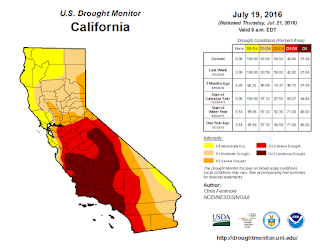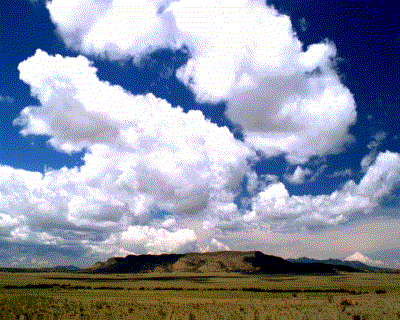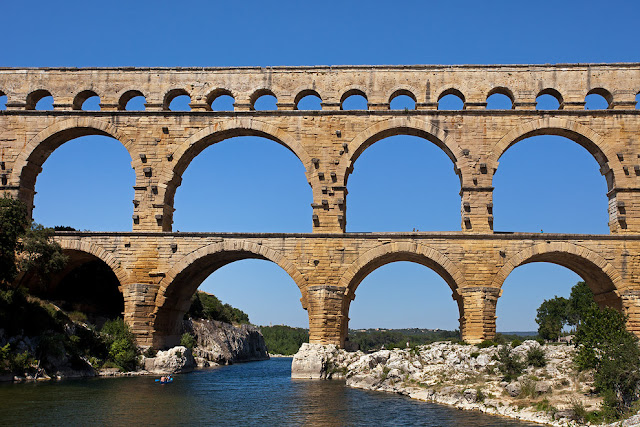For older students and adults
This is the link to my essay Water Economics, which was published in a different one of my blogs in August 2012. That page has been read more than 170,000 times, and that is more than half of the readership of that blog.Chapter 1. The Wet Planet.
The earth is very wet.Three-quarters of the surface of the earth is covered in water. The amount of water in all the world's oceans, lakes, rivers, and the clouds in the sky is about 330 cubic miles (1.38 billion cubic kilometers).
Click here to see more information on the amount of water in the earth.
| This is what the earth looks like from space. After you see North and South America, you will see a large area of blue. |
That large blue area is the Pacific Ocean, the largest ocean in the world.
| This is a map of the Pacific Ocean. It is the largest ocean in the world. North America is next to it in the upper-right part of this map. Three states are right next to this ocean. They are California, Oregon, and Washington. Hawaii, another state, is a group of islands in this ocean. |
Chapter 2. Drought kills.
Some parts of the earth that people live on doesn't have enough water to drink. This is called a drought. This paragraph is on the drought page of the United States Geological Service.
A drought is a period of drier-than-normal conditions that results in water-related problems. When rainfall is less than normal for several weeks, months, or years, the flow of streams and rivers declines, water levels in lakes and reservoirs fall, and the depth to water in wells increases. If dry weather persists and water-supply problems develop, the dry period can become a drought.People and animals need water to stay alive. Every plant also needs water to stay alive, so the amount of water that is in the ground is important to plants. If there is too much water, which can be caused by a flood, the health of the plant will suffer. The plant may even die. If there is not enough water, which can be caused by drought, it also hurts the ability of a plant to stay alive. Plants, animals, and people can also die from the lack of water.
Drought in India
|
The plants above are sugarcane plants,
but they died from the lack of water. Many Indian farmers have killed themselves. |
| In the photo below, each of these containers holds water. These women are carrying it so their families won't go thirsty. |
Their families have to make this trip every day, so that they can have water to drink, water to cook their food, and water to wash themselves and their clothes.
In the photo below, this water isn't clean, but it is the only water that his family has, so this boy has to carry it to his family, and they have to drink it and cook with it. Carrying water to a family is done every day because families need water every day.
Drought in Africa
|
This photo was taken in eastern Africa in 2011.
These animals died of thirst. |
| The photo above shows a woman collecting water in a cup. Each cup of water goes into the large plastic bottle, which she will carry back to her home. This boy's family doesn't have much water, so when he needs a bath, they put him in this. |
|
| This animal hasn't had food or water in so long, you can see where all of its' bones are. The lack of water means that the plants that it wants to eat are dead or dying, |
These are the first four paragraphs of a story that was published December 4, 2015 in the Irish Times.
I am sitting here in Malawi wishing it would rain. I am sure many of you reading this back in Ireland are wishing the exact opposite.
In Malawi the coming of the rains means as much as a warm sunny day in Ireland. Everyone is in better form, everyone makes the most of it. The only difference is that Malawians need the rain to survive - literally.
The rain pattern in Malawi has been changing so much over the past number of years that farmers are confused. I am passing fields every day at the moment that are prepared and waiting to be planted. But the rural farmers tell me that in the past, the planting would be done by now and the rains would have already begun. And they could feel confident that they would be able to feed their families for another year. This is no longer the case.
One day two weeks ago, it did rain for a bit and you could sense the sheer joy and relief everywhere. But then it stopped and hasn’t come back. And after eight years living in Zimbabwe and Malawi I think the heat this year is the worst.
This is a clickable link to the whole story.
This is a clickable link to a story that was published by Reuters on December 23, 2015 titled Southern Africa faces food shortages as El Nino drought worsen.
This is a clickable link to a story that was published by Reuters on December 23, 2015 titled Southern Africa faces food shortages as El Nino drought worsen.
Three quarters of the earth's surface is water, so if some of this water can be sent to India and the African countries, their drought can end.
This can be done with the Water Cycle.
Chapter 3. The Water Cycle.
This four-step process is for elementary school students.
|
This diagram is for middle school students. It is a more complete diagram because it shows water going into the ground (infiltration) and water going from the ground, through plants, into the air (transpiration).
|
| This is the Water Cycle from the point of view of a plant. The precipitation can be either rain or snow. The roots take water from the soil. The leaves send the water into the air. |
- When clouds pass over a mountain, they leave small drops of moisture at the top of the mountain.
- These small drops of moisture combine into big drops, which combine into small streams of water that go down the mountain.
- Two or three small streams combine to form a small river. Two or three small rivers combine to form a big river. The map below shows how six different rivers add their water to the Mississippi River.
- The water in all of these rivers, as well as the water in ponds. lakes, and wetlands, is always evaporating. The earth's heat and the sun's heat is turning all of this water into steam. The roots of plants also collect moisture from the water that is in the ground. This moisture is transpired through the leaves of the plant into the air, and it also becomes steam.
- All of this steam rises into the air, and when it is high enough, the steam condenses. We call this condensed moisture "clouds".
- Wind currents move the clouds to other parts of the earth.
- Start over again at Step 1.
Chapter 4. The Water Cycle isn't being used in California!
There are parts of the world that do not have enough water, even though almost three-quarters of the earth's surface is covered in water. This is even true in California.This is recent information on the drought in California. In the diagram on the left, the yellow areas have bad drought. The red area has even worse drought. The dark red area in the southwestern part of California has the very worst drought. This is surprising, because the Pacific Ocean is right next to this state, as you can see in the diagram on the right.
The State Government doesn't manage its' water very well.
Not enough rain is falling in that state to allow the farmers to grow the plants that produce food. Many different kinds of fruit and vegetables used to grow there, but now, the land is so dry, the food plants are starving for water. Some of these plants have already died.
Fourth-generation Fresno Co. farmer Chris Hurd isn’t sure his farming operation will survive a fourth year of California’s historic drought. “”I stayed alive last year,” he says,” but I’m not sure I’ll make it this year. It’s a treacherous, sickening situation.
The sign on the fence in the other photo says, "Pray for Rain". We should all pray that rain falls in California, so that farmer Chris Hurd and many others like him can stay alive.
These are the third and fourth paragraphs of a story on the website Think Progress that was published May 5, 2015.
Agriculture requires water, and large-scale agriculture, like that in California, requires large amounts of water. So when Governor Brown came under fire for exempting farmers from the mandatory cuts — farmers use 80 percent of the state’s available water — he was unmoved.
“They’re not watering their lawn or taking long showers,” he told ABC’s “The Week” the Sunday after he announced the restrictions. “They’re providing most of the fruits and vegetables of America to a significant part of the world.”
The Governor of California says that farmers in his state are providing most of the fruits and vegetables of America to a significant part of the world, but this will end unless his state can get more rain than it has had recently.
There is another reason to pray for rain in California. Rain will help to put out the wildfires that are killing people, animals, and plants.
When there are more clouds over California, they can produce more rain. The rain will help to end these fires. Rain is part of the Water Cycle.
| Chapter 5. Let's cook the recipe for the Water Cycle! |
List of Ingredients
|
The missing ingredient is water. There isn't enough water inside California for the people, animals, and plants. All of these living things are starving for water. Some of them are dying. Some of them have already died.
The inside of California doesn't have enough water, but there is an ocean of water outside of California. Let's send some water from this ocean to a dry valley in eastern California.
| A valley is the space between mountains. There are different kinds of valleys. This valley has a small river that runs through it. |
| This valley has a lake in between the mountains. It also has a rainbow over the lake, caused by the refraction of the water. |
| Some valleys have no water at all. The land is so dry, the sun has baked the earth, just as if it had been placed into a hot oven. |
| This valley is called Death Valley. It is in between the Pinamint Mountain Range and the Amargosa Mountain Range. This valley is 140 miles long, and it is very hot. This animal couldn't get enough water to stay alive, so it died. Many people, animals, and plants have died there. |
Death Valley is the green area in this map. Almost all of it is in California, but a little bit of it is in Nevada.
This is a map of the geography of Death Valley, showing the two mountain ranges that are its' east and west borders.
Most of this valley is lower than the level of the Pacific Ocean. At its' lowest point, it is 282 feet lower than the midpoint between that ocean's high tide and low tide.
Every valley is like a bowl. If the valley has water in it, the mountains hold the water in. The temperature in this valley is very hot, so even when the valley has an occasional flood, the water enters the water cycle. It evaporates, but the rainwater from the clouds always goes somewhere else because the wind moves the clouds to other parts of the area.
| The video on the left shows how hot it can be here. The temperature can be 130° F. That's 55° Celsius. Any time water is in this valley, it quickly evaporates. The water becomes steam. |
| In most years, there is less than two inches of rainfall in this valley, but in October 2015, there was a flood. The video on the right shows it. It happened very quickly, so it is called a flash flood. |
 Since Death Valley is hundreds of feet lower than the Pacific Ocean, if there was a pipe that connected the Pacific Ocean to the valley, water from the ocean would flow through the pipe and fill the valley. This would create a lake in between the two mountain ranges that border this valley.
Since Death Valley is hundreds of feet lower than the Pacific Ocean, if there was a pipe that connected the Pacific Ocean to the valley, water from the ocean would flow through the pipe and fill the valley. This would create a lake in between the two mountain ranges that border this valley.The photo on the right shows different containers that hold water. No matter what size or shape of a container is used, if water can flow from any one of these containers to another container, the water level will always be the same.
The Pacific Ocean is held inside the Pacific Basin. Death Valley is the space between two mountain ranges. It is also a basin. If there was a way to transport water from the Pacific Ocean to Death Valley, it would create a lake that has the same water level as the Pacific Ocean.
When all this was done, the lake became a reservoir. The Quabbin Reservoir holds drinking water for many of the people in Massachusetts to use in their homes, schools, and businesses.
Link to the written history of the Quabbin Reservior.
Link to a very long timeline of events that led to the creation of this reservoir.
Link to a very long timeline of events that led to the creation of this reservoir.
A pipe, like the one shown above, could transport water from the Pacific Ocean to Death Valley. The height of the western end of this pipe would be almost 300 feet higher than the height of the eastern end of the pipe, so water would do downhill through the pipe, and if there were some water pumps added to this pipe, water would fill up Death Valley, creating a lake.

On the right is a diagram of a water pump that is used by companies to transport large amounts of water quickly.
Engineers would decide how many pumps to install so that the valley would fill with water quickly.
In the beginning of this process, most of the water that enters the valley would become groundwater. This would allow people who live in the area to become farmers, growing food crops that would help many others in the area who are hungry.
After the valley becomes a lake, the pumps would not need to transport as much water because they would only need to replace the amount of water that would evaporate in a year.
Start the Water Cycle !!
- The water will form a lake
- Water will evaporate from that valley, forming clouds.
- The clouds will migrate to other parts of the area.
- Wherever the wind moves the clouds, it will eventually rain.
- When the wind moves the clouds over California, it will rain there.
- Go back to step 1.
 Do you live in California? Do you like eating locally-grown fruit? Tell your friends how much you want to see fruit trees growing in California. You'll be my Chef of the Day!
Do you live in California? Do you like eating locally-grown fruit? Tell your friends how much you want to see fruit trees growing in California. You'll be my Chef of the Day!
Chapter 6. The Water Cycle begins !
Step 1. The sun's heat and the earth's heat turns some of this liquid water into water vapor. The water vapor rises into the atmosphere. |
|
| Step 2. When the water vapor is high enough in the air, it gets cold and it condenses. It changes back into liquid, forming clouds. |
|
|
Cumulus = pieces of floating cotton
|
Step 3. The wind blows !!
| The wind moves the droplets of water through the atmosphere from Death Valley to other parts of the southwest. The direction of the wind will change sometimes. |
Link to a page that shows the direction of wind currents in southern California right now.
| Sometimes, the water droplets in the clouds will go west from Death Valley to the areas of California that have been suffering from drought for years. |
| Step 4. The clouds precipitate their moisture. It can be rain, snow, sleet, or hail in most areas of the country, but snow doesn't happen very often in California. |
|
| When the moisture falls in California, it will add water to lakes, rivers, and to groundwater. This photo shows the Hollywood Walk of Fame during a rainstorm. |
| This video is a 3-D animation of a growing tree. When there is more rainfall in California, you will see more trees growing there. Some of these trees will have fruit on them. California will also have more grape vines. |
California will have lots of juicy fruit for its' families to eat, including oranges and grapes !
|
I love oranges, especially the juicy ones, and I love grapes, too!
Farmers can't grow juicy oranges and grapes unless the ground is moist. |
Chapter 7. Transporting water in Ancient Rome
In 300 B.C. there were already ways to transport water across great distances. The water traveled downhill for miles before it reached the City of Rome, where people were waiting to drink it, cook with it, and take baths in it.Sometimes, the water traveled in man-made tunnels through mountains, and other times, the water traveled across valleys on structures called aqueducts.
The photo below shows an aqueduct that was built centuries ago.
These two videos tell the history of the heroic engineering achievement that was made so that those ancient people could have water to drink.
Chapter 8. Let's Get Started !
Let's build an aqueduct, using pipes like this, from the Pacific Ocean to Death Valley.| I'm already hungry for a California orange! |



















































